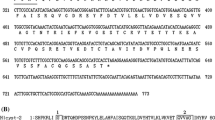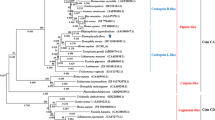Abstract
The gene encoding cystatin from the tick Haemaphysalis longicornis has been reported previously. In the study reported here, we characterized a member of cystatins and designated it as Hlcyst-3 (H. longicornis cystatin-3). Its full-length cDNA is 602 bp, and it encodes a putative 129 amino acid protein with an obvious signal peptide. Sequence analysis revealed that it has significant homology with the known secreted cystatin. The recombinant protein was expressed in a GST-fused soluble form in Escherichia coli and was purified by affinity chromatography. The inhibitory activity of the recombinant protein against papain and cathepsin L was identified by fluorogenic substrate analysis. Real-time PCR revealed that Hlcyst-3 was mostly expressed in the tick midgut.



Similar content being viewed by others
References
Agarwala KL, Kawabata S, Hirata M, Miyagi M, Tsunasawa S, Iwanaga S (1996) A cysteine protease inhibitor stored in the large granules of horseshoe crab hemocytes: purification, characterization, cDNA cloning, and tissue localization. J Biochem 119:85–94
Barrett AJ, Rawlings ND, Davies ME, Machleidt W, Salvesen G, Turk V (1986) In: Barret AJ, Salvesen G (Eds.) Cysteine proteinase inhibitors of the cystatin superfamily in protease inhibitors. Elsevier, New York, pp. 515–569
Bjork I, Brieditis I, Raub-Segall E, Pol E, Hakansson K, Abrahamson M (1996) The importance of the second hairpin loop of cystatin C for proteinase binding. Characterization of the interaction of Trp-106 variants of the inhibitor with cysteine proteinases. Biochemistry 35:10720–10726
Brown WM, Dziegielewska KM (1997) Friends and relations of the cystatin superfamily–New members and their evolution. Protein Sci 6:5–12
Dainichi T, Maekawa Y, Ishii K, Zhang T, Nashed BF, Sakai T, Takashima M, Himeno K (2001) Nippocystatin, a cysteine protease inhibitor from Nippostrongylus brasiliensis, inhibits antigen processing and modulates antigen-specific immune response. Infect Immun 69:7380–7386
Frejie JP, Abrahamson M, Olafssonn I, Velasco G, Grubb A, Lopez-Otin C (1991) Structure and expression of the gene encoding cystatin D, a novel human cysteine inhibitor interaction. EMBO J 9:1939–1947
Fujisaki K (1978) Development of acquired resistance and precipitating antibody in rabbits experimentally infested with females of Haemaphysalis longicornis (Ixodoidea: Ixodidae). Natl Inst Anim Health Quart (Tokyo) 18:27–38
Fujisaki K, Kawazu S, Kamio T (1994) The taxonomy of the bovine Theileria spp. Parasitol Today 10:31–33
Goto SG, Denlinger DL (2002) Genes encoding two cystatins in the flesh fly Sarcophaga crassipalpis and their distinct expression patterns in relation to pupal diapause. Gene 292:121–127
Grunclova L, Horn M, Vancova M, Sojka D, Franta Z, Mares M, Kopacek P (2006) Two secreted cystatins of the soft tick Ornithodoros moubata: differential expression pattern and inhibitory specificity. Biol Chem 387:1635–1644
Jongejan F, Uilenberg G (2004) The global importance of ticks. Parasitology 129:S3–S14
Karim S, Miller NJ, Valenzuela J, Sauer JR, Mather TN (2005) RNAi-mediated gene silencing to assess the role of synaptobrevin and cystatin in tick blood feeding. Biochem Biophys Res Commu 334:1336–1342
Kotsyfakis M, Sa-Nunes A, Francischetti IM, Mather TN, Andersen JF, Ribeiro JM (2006) Anti-inflammatory and immunosuppressive activity of sialostatin L, a salivary cystatin from the tick Ixodes scapularis. J Biol Chem 281:26298–26307
Kotsyfakis M, Karim S, Andersen JF, Mather TN, Ribeiro JM (2007) Selective cysteine protease inhibition contributes to blood-feeding success of the tick Ixodes scapularis. J Biol Chem 282:29256–29263
Lima CA, Sasaki SD, Tanaka AS (2006) Bmcystatin, a cysteine proteinase inhibitor characterized from the tick Boophilus microplus. Biochem Biophys Res Commun 347:44–50
Manoury B, Gregory WF, Maizels RM, Watts C (2001) Bm-CPI- 2, a cystatin homolog secreted by the filarial parasite Brugia malayi, inhibits class II MHC-restricted antigen processing. Curr Biol 11:447–451
Mulenga A, Sugimoto C, Ingram G, Ohashi K, Onuma M (1999) Molecular cloning of two Haemaphysalis longicornis. Cathepsin L-like cysteine proteinase genes. J Vet Med Sci 61:497–503
Rawlings ND, Barrett AJ (1990) Evolution of proteins of the cystatin superfamily. J Mol Evol 30:60–71
Schultz J, Copley RR, Doerks T, Ponting CP, Bork P (2000) SMART: a web-based tool for the study of genetically mobile domains. Nucleic Acids Res 28:231–234
Tsuji N, Miyoshi T, Battsetseg B, Matsuo T, Xuan X, Fujisaki K (2008) A cysteine protease is critical for Babesia spp. transmission in Haemaphysalis ticks. PLoS Pathog 16(4(5)):e1000062
Turk V, Bode W (1991) The cystatins: protein inhibitors of cysteine proteinases. Fed Eur Biol Soc Lett 285:213–219
Yamamoto Y, Watabe S, Kageyama T, Takahashi S (1999) Purification and characterization of Bombyx cysteine proteinase specific inhibitors from the hemolymph of Bombyx mori. Arch Insect Biochem Physiol 41:119–129
Zhou J, Ueda M, Umemiya R, Battsetseg B, Boldbaatar D, Xuan X, Fujisaki K (2006) A secreted cystatin from the tick Haemaphysalis longicornis and its distinct expression patterns in relation to innate immunity. Insect Biochem Mol Biol 36:527–535
Zhou J, Liao M, Ueda M, Gong H, Xuan X, Fujisaki K (2009) Characterization of an intracellular cystatin homolog from the tick Haemaphysalis longicornis. Vet Parasitol 160:180–183
Acknowledgments
This work was supported by a grant from the Bio-oriented Technology Research Advancement Institution (BRAIN), Grants-in-Aid for Scientific Research (A) from the Japan Society for the Promotion of Science, and a grant from the 21st Century COE program (A-1), Ministry of Education, Sports, Science, and Technology of Japan.
Author information
Authors and Affiliations
Corresponding author
Rights and permissions
About this article
Cite this article
Zhou, J., Liao, M., Gong, H. et al. Characterization of Hlcyst-3 as a member of cystatins from the tick Haemaphysalis longicornis . Exp Appl Acarol 51, 327–333 (2010). https://doi.org/10.1007/s10493-010-9336-1
Received:
Accepted:
Published:
Issue Date:
DOI: https://doi.org/10.1007/s10493-010-9336-1




